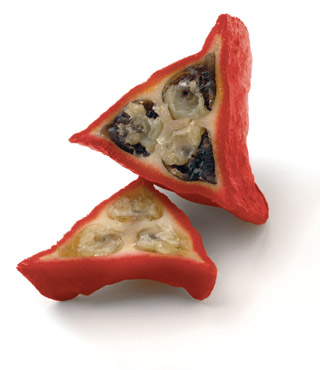In the same category as monk fruit and stevia, Thaumatin is used to sweeten food and drinks naturally. It has been used by the West Africans for hundreds of years, but is little known to us. I shine the spotlight on this mysterious sweet stuff.
What is it?
Thaumatin is a protein which is isolated from the katemfe fruit, Thaumatococcus daniellii, also called "the miraculous fruit of the Sudan." Katemfe is common in the West African rain forest zone. The fruit contains 1-3 black seeds surrounded by a gel, and capped with a membranous sac, the aril, which contains the sweet material. This is used as a sweetener in cooking, in flavoring palm wine, and in healthy alternatives to sugary treats.

History
The power of Thaumatin’s taste enhancement properties have been known for hundreds of years - used by the West Africans to sweeten corn breads and sour fruits.
It was first brought to the attention of the western world in the 1840's when, during a posting to the region, British Army Surgeon, W F Daniell, made note of how the locals used Thaumatin. He later reported his findings in a pharmaceutical journal. In the 1970s, great emphasis was placed on Thaumatin’s sweetening properties and for some time this defined its marketing path.
Nutrition
Thaumatin is a protein, so it has 4 calories per gram. Since it has such high potency relative to sugar, the amount used is so extremely small, it does not provide measurable calories when used in food.
Like stevia, thaumatin has been used for centuries and shows no signs of danger to human health. Thaumatin is digested like any other protein, so there is no concern about toxicity.
Thaumatin is listed as being 2000-3000 times sweeter than sucrose (sugar) and does not contribute any calories to the diet.
Taste
Thaumatin is sweet, with a slow onset, lingering sweetness and slight licorice after-taste. It is about 2000 times sweeter than table sugar, gram for gram.
Availablility
While you will struggle to find this on the shelves of the supermarket for use in baking, you may see it added to some of your foods. Always read the ingredients label and recognise what is in there! It's time to get educated, Fitties.

Follow me: @thefitfoodieblog
[convertkit form=5183433]



I have never heard of this sweetener which is a pity as I recently bought a product called Beauty Dust and after carefully checking the ingredients to see if it contained any artificial sweeteners. There was one ingredient on the list that I didn’t recognise, Thaumatin, but I didn’t know this to be an artificial sweetener, so I bought the product and started to use it. It had the same nasty bitterness that I taste in all artificial sweeteners and also in stevia and unfortunately has started the drug reaction that I also get from all artificial sweeteners INCLUDING the so-called natural stevia, namely a burning, itchy rash which usually lasts for about 8 weeks. I have also noticed that this bitter taste has continued to linger and it has also made me extremely thirsty.
Hello Melissa, thank you for your comment, I too do not like stevia and have just bought a protein powder which has thaumatin on the ingredients label. I really like xylotol as a sweetener, no after taste..
This isn’t an artifical sweetener . . . ?? Maybe you have an allergy. Stevia is also not an artificial, and is a ragweed, therefore, highly allergenic.
You’re correct Rach – it’s not artificial. It is processed (the way we buy it here in Aus) but so is granulated white stevia, which is naturally derived too. Artificial sweeteners are those made via a chemical process to make ‘food-like substances’.
There is a “sugar” called D-Ribose that I mix with xylitol and coconut nectar sweetener. It has amazing health benefits and tho expensive has amazing health benefits so worth the extra $.